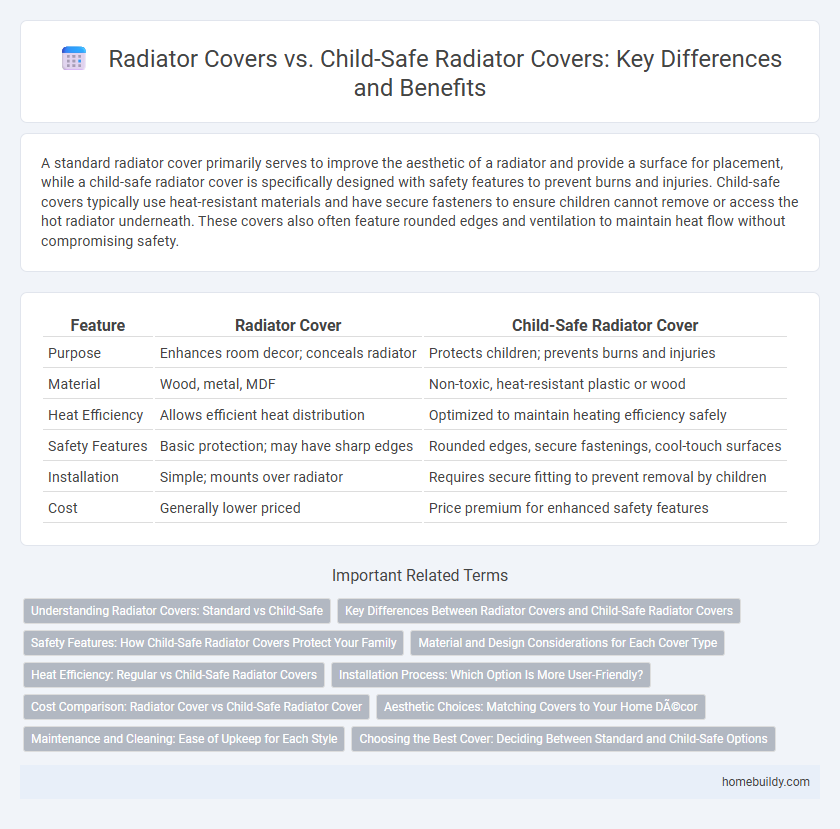A standard radiator cover primarily serves to improve the aesthetic of a radiator and provide a surface for placement, while a child-safe radiator cover is specifically designed with safety features to prevent burns and injuries. Child-safe covers typically use heat-resistant materials and have secure fasteners to ensure children cannot remove or access the hot radiator underneath. These covers also often feature rounded edges and ventilation to maintain heat flow without compromising safety.
Table of Comparison
| Feature | Radiator Cover | Child-Safe Radiator Cover |
|---|---|---|
| Purpose | Enhances room decor; conceals radiator | Protects children; prevents burns and injuries |
| Material | Wood, metal, MDF | Non-toxic, heat-resistant plastic or wood |
| Heat Efficiency | Allows efficient heat distribution | Optimized to maintain heating efficiency safely |
| Safety Features | Basic protection; may have sharp edges | Rounded edges, secure fastenings, cool-touch surfaces |
| Installation | Simple; mounts over radiator | Requires secure fitting to prevent removal by children |
| Cost | Generally lower priced | Price premium for enhanced safety features |
Understanding Radiator Covers: Standard vs Child-Safe
Standard radiator covers primarily serve aesthetic and protective functions, concealing unsightly radiators while preventing direct contact with hot surfaces. Child-safe radiator covers enhance these features with reinforced materials, rounded edges, and better heat insulation to reduce burn risks, ensuring increased safety in homes with young children. Selecting the appropriate cover depends on balancing design preferences with critical safety requirements for child-proofing heated areas.
Key Differences Between Radiator Covers and Child-Safe Radiator Covers
Radiator covers primarily enhance room aesthetics and protect radiators from dust, while child-safe radiator covers prioritize safety by including features like heat-resistant materials and secure locking mechanisms to prevent burns. Child-safe covers often have rounded edges and thicker insulation to reduce surface temperature, minimizing injury risks for children. Unlike standard radiator covers, child-safe versions comply with safety standards and regulations specifically designed to protect young children from heat-related hazards.
Safety Features: How Child-Safe Radiator Covers Protect Your Family
Child-safe radiator covers feature non-toxic materials and smooth edges designed to prevent burns and injuries, ensuring enhanced protection compared to standard radiator covers. These covers often include insulated panels that reduce surface temperatures, minimizing the risk of accidental contact burns among children. Reinforced construction and secure fittings provide added stability, reducing hazards related to tipping or detachment in active household environments.
Material and Design Considerations for Each Cover Type
Radiator covers are commonly made from wood or metal, offering durability and a decorative appeal, while child-safe radiator covers prioritize non-toxic, heat-resistant materials like plastic or coated metals to prevent burns and injuries. The design of standard radiator covers often emphasizes aesthetics and room integration, featuring open grilles for heat flow, whereas child-safe versions incorporate enclosed structures with rounded edges and secure fastenings to enhance safety. Both cover types balance heat efficiency, but child-safe covers sacrifice some heat output to ensure maximum protection for children.
Heat Efficiency: Regular vs Child-Safe Radiator Covers
Regular radiator covers often provide better heat efficiency due to their minimal insulation design, allowing more warmth to radiate freely into the room. Child-safe radiator covers, however, prioritize safety features such as insulated panels and protective barriers, which can slightly reduce heat output and increase heat retention within the cover. Choosing a child-safe radiator cover involves balancing the need for effective heat distribution with enhanced protection against burns and injuries for young children.
Installation Process: Which Option Is More User-Friendly?
Standard radiator covers generally feature straightforward installation with basic tools such as screws and brackets, making them accessible for most homeowners. Child-safe radiator covers often require additional safety features like rounded edges, secure locking mechanisms, and heat-resistant materials, which can complicate the installation process. Users seeking a balance between ease of installation and enhanced safety may find child-safe covers require more time and effort but offer greater protection in homes with young children.
Cost Comparison: Radiator Cover vs Child-Safe Radiator Cover
Radiator covers typically cost between $50 and $150, offering basic protection and aesthetic enhancement for standard heating units. Child-safe radiator covers, designed with durable materials and rounded edges to minimize injury risks, usually range from $100 to $300, reflecting their enhanced safety features and compliance with child safety standards. Investing in a child-safe radiator cover often means higher upfront costs but greater peace of mind in environments with young children.
Aesthetic Choices: Matching Covers to Your Home Décor
Radiator covers come in various styles and materials, allowing homeowners to blend them seamlessly with their existing interior design, from classic wood finishes to sleek metal or painted options. Child-safe radiator covers prioritize both safety and aesthetics by incorporating rounded edges, non-toxic paints, and durable construction while maintaining design flexibility to complement living spaces. Choosing the right cover involves balancing safety features with your decor preferences to create a harmonious and secure environment.
Maintenance and Cleaning: Ease of Upkeep for Each Style
Radiator covers require regular dusting and occasional repainting to maintain their appearance, with open slats allowing easier access for cleaning. Child-safe radiator covers prioritize smooth, enclosed surfaces, minimizing dust accumulation and reducing sharp edges, which simplifies wiping and prevents injury risks. Both styles benefit from materials like wood or metal that withstand cleaning agents, but child-safe designs often require less intensive upkeep due to their sealed construction.
Choosing the Best Cover: Deciding Between Standard and Child-Safe Options
Choosing between a standard radiator cover and a child-safe radiator cover depends on the level of protection needed in your home environment. Child-safe covers offer enhanced insulation and rounded edges to prevent burns and injuries, making them ideal for households with young children. Standard covers prioritize aesthetics and heat efficiency but may lack the safety features crucial for childproofing.
Radiator cover vs Child-safe radiator cover Infographic

 homebuildy.com
homebuildy.com